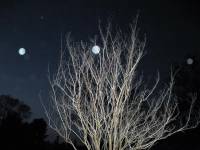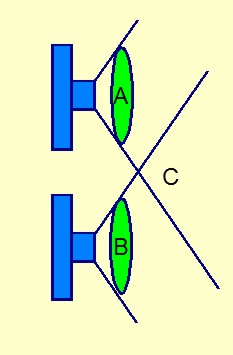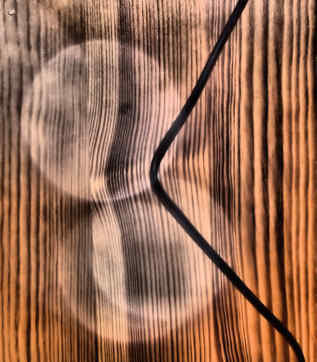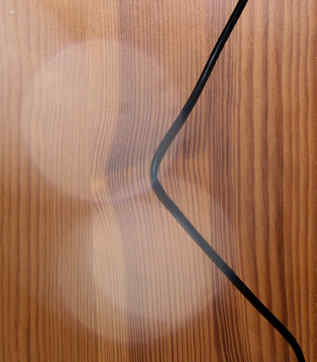Orbs - Reasons to believe

Two camera orbs
Project Orbit was an experiment planned by ASSAP that, for several reasons, never happened. The idea was to have two cameras, next to each other, looking at the same scene. In the diagram below you can see the setup of two cameras with their fields of view shown by diverging lines.

Suppose you synchronise the cameras so that they both take a photo at exactly the same time, both using their own flash. Any object in the area where the fields of view overlap (C, in the diagram) will show up on both pictures. If orbs are really 'out there', as opposed to being photographic artifacts, they should show up in both photos.
However, if orbs are really bits of dust very close to the camera lens, they will only appear in one photo or the other but NOT both! The reason is that each camera has its own 'orb zone' where dust is close enough for the flash to show it up as an orb. However, these orb zones (shown by the green ellipses in the diagram) are very close to the lens. So a bit of dust in zone A will only be seen by one camera. Similarly, dust in zone B will only become an orb to the other camera.
It is highly unlikely that the orb zones would stretch out as far as the area where the two camera's fields of view overlap. So orbs would only appear in one photo or the other but not both. This demonstrates that orbs are out of focus bits of dust extremely close to the camera lens.
The group Parascience has now done a similar experiment, though using a far more convenient 3D camera, and they found all the orbs they photographed WERE artifacts..
The science of orbs
Dave Wood, of ASSAP, has done some formal scientific research into orbs. These were published in Anomaly 40 and can be read here - Testing Orb Zone Theory. The main conclusions are that:
- Orbs occur equally in haunted locations and non-haunted ones
- Orb numbers are primarily related to camera depth of field and distance of flash from the lens
- These results confirm the theory that orbs are produced in the orb zone (see above).
Paranormal orbs
Despite the overwhelming evidence that orbs are tiny out of focus particles caught in the flash just in front of camera lenses, some people still think they are paranormal (if the web is any indicator).
So what aspects of orbs do people believe indicate that some, at least, might be paranormal?
- Orbs appear in haunted locations
- Some orbs seem to have faces
- There are rare 'special orbs'
- Some orbs appear to interact with objects
There are, no doubt, other reasons to believe orbs are paranormal but let's look at these.
- The idea that orbs only occur in haunted locations has been refuted by scientific studies (see below left)
- Orbs having 'faces' is an illusion, like the 'man in the moon' or simulacrums
- 'Special orbs' include coloured orbs, oddly shaped orbs, bright isolated orbs, etc. which have all been explained (follow the links for details)
If orbs really interacted with objects in the photo, they would be 'out there' and not very close to the lens. A typical example is objects that appear to be in front of an orb.

Orb behind cable

Cable behind orb
Sometimes an orb appearing behind something is just an illusion (where the orb is so pale that a strongly lit feature behind effectively overwhelms the faint details of orb in front*). However, look at the photos above. In the top one, the black cable appears to be in front of the orbs because it looks complete. However, the photo below is the original, where it is obvious the cable is actually behind the orb.
The top photo has been 'enhanced' with photo software, produced from the one below. This is an example of over-processing data until it becomes significantly different from the original. It is easy to do this with both photographs and sound recordings. Photos apparently showing objects throwing shadows onto orbs (or orbs casting shadows) are probably over-processed. Always check the original photo!
* Digital cameras have less latitude (ability to show detail in dark or light areas) than film cameras.
Try this...
For those who are unconvinced that orbs are bits of dust, here are some experiments you can try.. It is in the nature of experiments that they will not always 'work' but most times they will.
Preparation
Next time you are taking photos and you notice, by reviewing using the screen on the back of your camera, that you are getting orbs, try these experiments. All require flash to be used.
First, point the camera in one direction (towards an unchanging scene) and take all your experimental photos in that same direction. Ideally, use a tripod but, if not available, try putting your camera on a table to make sure it always takes the same scene.
Then take a few 'control' shots to make sure you are getting orbs. Now take some more shots as follows.
Experiment 1
If you can, put your camera into its 'Macro' setting and take a photo. This setting is normally used for close ups. If you are using a DSLR, you will need a lens with Macro capability.
Experiment 2
Switch back to normal photo setting (from Macro). Then place an object close in front of the camera and press the shutter release, without taking a photo, so that it auto-focuses on the object (this should work on most modern cameras). Then switch auto-focus off temporarily. Remove the close object and take a photo so that the background scene is out of focus.
Experiment 3
Look through all your photos of orbs. What is the maximum size they reach relative to the overall frame size?
Results
You should notice in Experiment 1 that there will many more orbs than on the control. This is because Macro brings nearer the nearest point that is in focus.
In Experiment 2, any orbs should appear normal despite the out of focus background. Everything in the picture is too close to be in focus, including the orbs! It shows orbs are out of focus bits of dust.
In Experiment 3 you won't find any orbs bigger than about one tenth of the frame size. If they were 'out there' wouldn't you expect a few to be be bigger?